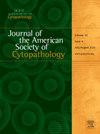Oncocytic subtype of well differentiated neuroendocrine tumor: clinicopathologic and molecular associations of a cohort diagnosed on fine needle aspiration (FNA)
Q2 Medicine
Journal of the American Society of Cytopathology
Pub Date : 2025-03-27
DOI:10.1016/j.jasc.2025.03.004
引用次数: 0
Abstract
Introduction
Classical well differentiated neuroendocrine tumors (C-NETs) have plasmacytoid morphology and neuroendocrine differentiation. Oncocytic NETs (O-NETs) have been shown to be more clinically aggressive. Whether O-NETs are more akin to C-NETs or poorly differentiated neuroendocrine carcinomas (PDNECs) is not established.
Materials and methods
Clinicopathologic characteristics and immunohistochemical expression of death domain-associated protein (DAXX), α-thalassemia/mental retardation syndrome X-linked genes (ATRX), retinoblastoma 1, p53, and SMAD4 in 30 O-NETs (25 pancreatic and 4 from luminal gastrointestinal tract) was compared to 32 C-NETs (23 pancreatic and 8 from luminal gastrointestinal tract). Whole exome sequencing was performed in a subset of each cohort.
Results
O-NETs were male-predominant (65.6%) and had higher mean Ki-67 index (7.4% versus 2.9% in C-NETs) (P = 0.03), corresponding to more grade 2 or above (53.3%) tumors. O-NET patients had more advanced disease (pT3/pT4, 75% versus 36.8%) (P = 0.024), distant metastasis (50% versus 25%) (P = 0.042), progression (increased size/recurrence/new metastases) (n = 8 versus 3; P = 0.1), and death (n = 3 versus 1; P = 0.32). Forty percent of O-NETs (versus 12.5% of C-NETs; P = 0.041) showed DAXX/ATRX loss, with one showing coexisting retinoblastoma 1 and SMAD4 loss. P53 staining pattern was wild type in all cases. Whole exome sequencing of 10 cases showed DAXX, ATRX, and multiple endocrine neoplasia type 1 alterations in O-NETs and C-NETs, and coexisting DNMT3A and MTOR alterations in one O-NET.
Conclusions
O-NET subtype is associated with advanced disease and unfavorable outcomes compared to C-NETs. O-NETs are cytologically distinct, male-predominant tumors that often present with higher grade and advanced disease. Their aggressive behavior is possibly related to frequent DAXX/ATRX loss and less likely PDNEC-related molecular alterations. Pathologists should be mindful of this aggressive morphologic subtype and clearly convey its presence in pathology reports.
高分化神经内分泌肿瘤的嗜瘤细胞亚型:细针穿刺诊断队列的临床病理和分子关联。
经典的高分化神经内分泌肿瘤(C-NETs)具有浆细胞样形态和神经内分泌分化。肿瘤细胞性NETs (O-NETs)在临床上更具侵袭性。O-NETs是否更类似于C-NETs或低分化神经内分泌癌(PDNECs)尚未确定。材料和方法:比较30例O-NETs(25例胰腺,4例管腔胃肠道)和32例C-NETs(23例胰腺,8例管腔胃肠道)中死亡结构域相关蛋白(DAXX)、α-地中海贫血/智力低下综合征x连锁基因(ATRX)、视网膜母细胞瘤1、p53和SMAD4的临床病理特征和免疫组化表达。在每个队列的一个子集中进行全外显子组测序。结果:O-NETs以男性为主(65.6%),平均Ki-67指数较高(7.4%比2.9%)(P = 0.03),对应较多的2级及以上肿瘤(53.3%)。O-NET患者有更多的晚期疾病(pT3/pT4, 75%对36.8%)(P = 0.024)、远处转移(50%对25%)(P = 0.042)、进展(体积增大/复发/新转移)(n = 8对3;P = 0.1)和死亡(n = 3 vs .1;P = 0.32)。40%的o - net(相对于12.5%的c - net;P = 0.041)显示DAXX/ATRX缺失,其中1例显示视网膜母细胞瘤1和SMAD4缺失共存。所有病例P53染色模式均为野生型。10例患者的全外显子组测序显示,O-NETs和C-NETs中DAXX、ATRX和多发性内分泌肿瘤1型改变,一个O-NET中DNMT3A和MTOR共存改变。结论:与C-NETs相比,O-NET亚型与晚期疾病和不良预后相关。O-NETs是细胞学上独特的,以男性为主的肿瘤,通常表现为更高级别和晚期疾病。他们的攻击行为可能与频繁的DAXX/ATRX丢失和不太可能的pdnec相关分子改变有关。病理学家应该注意这种侵略性的形态亚型,并在病理报告中清楚地传达它的存在。
本文章由计算机程序翻译,如有差异,请以英文原文为准。
求助全文
约1分钟内获得全文
求助全文
来源期刊

Journal of the American Society of Cytopathology
Medicine-Pathology and Forensic Medicine
CiteScore
4.30
自引率
0.00%
发文量
226
审稿时长
40 days
 求助内容:
求助内容: 应助结果提醒方式:
应助结果提醒方式:


